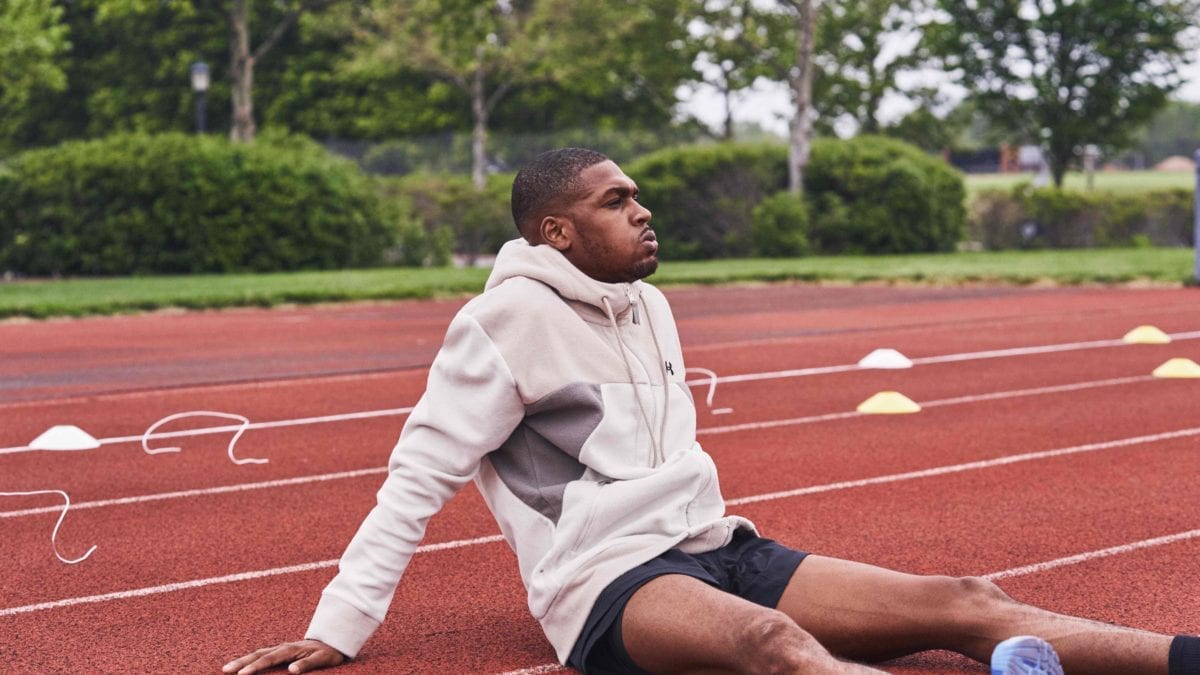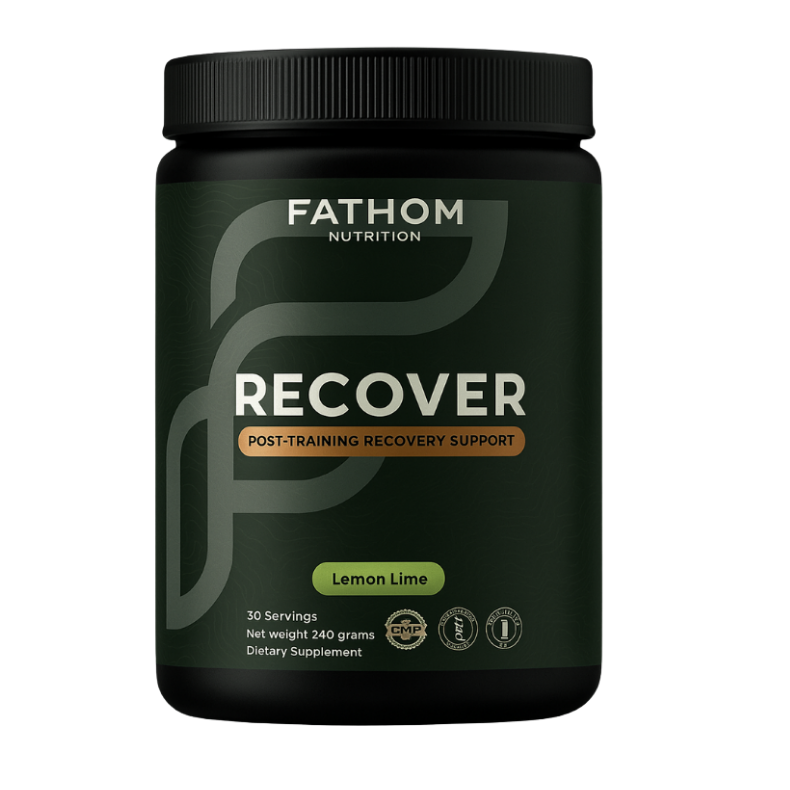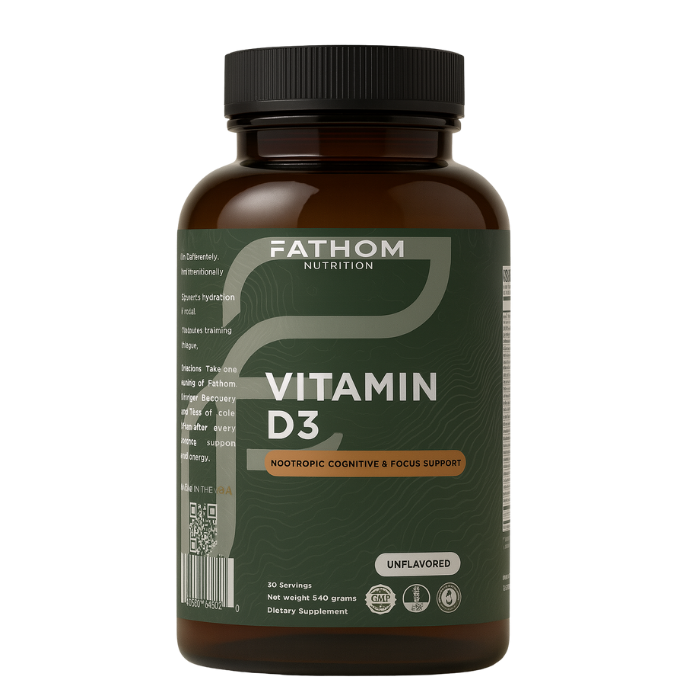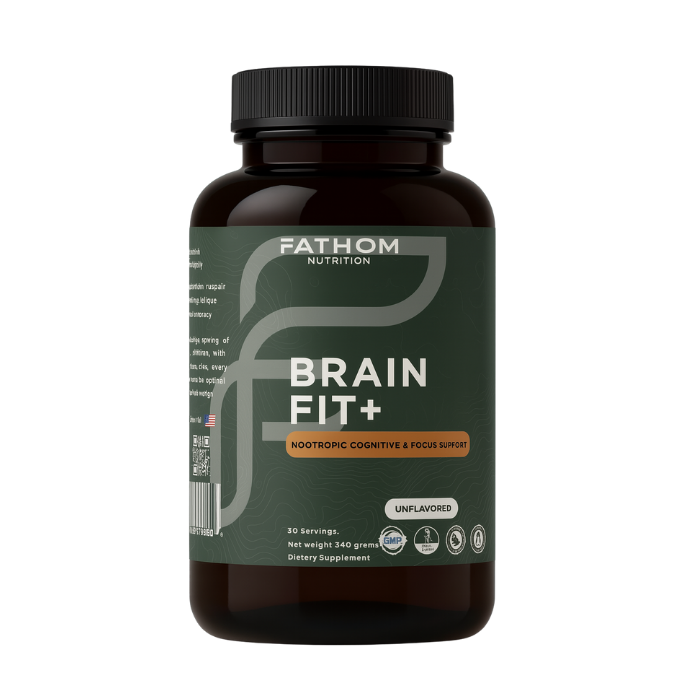Do Recovery and Hydration Supplements Actually Work? A Scientific Field Guide for Serious Athletes

Recovery is not passive. It is a sequence of cellular and systemic tasks that your body executes after training: restore fluid and electrolytes, reestablish plasma volume, normalize membrane excitability, resynthesize glycogen, repair contractile proteins, and reset the nervous system so you can produce high-quality force tomorrow. Smart recovery nutrition leans on three pillars.
-
Hydration and electrolytes. Replace fluid losses while targeting sodium first, since sodium drives fluid retention and reduces the risk of dilutional hyponatremia during long or hot sessions. Position statements and reviews typically recommend sports beverages with about 10–30 millimoles of sodium per liter, roughly 230–690 milligrams per liter, and total intakes near 300–600 milligrams per hour in prolonged efforts. Individual sweat sodium spans a very wide range, so personalization is essential. PMC+2PubMed+2
-
Energy and substrates. For training that runs beyond an hour, carbohydrate during and after exercise improves performance and speeds recovery through faster glycogen resynthesis. Multiple-transportable carbohydrate strategies allow higher intakes for very long sessions. Protein intake in the range of about 0.25 to 0.40 grams per kilogram per feeding with adequate leucine supports muscle protein synthesis across the day. PMC+2PubMed+2
-
Recovery actives with human data. Select compounds can moderate soreness, maintain training quality, and support adaptation when used alongside training and nutrition. Evidence is strongest for tart cherry and L-carnitine L-tartrate in the context of exercise-induced muscle damage, with emerging performance and osmolyte support from betaine, and stress-resilience signals from ashwagandha. Lippincott Journals+4PubMed+4MDPI+4
Where RecoverFIT fits: it combines electrolytes with a focused stack of recovery actives and adaptogenic support, with transparent labeling and third-party testing referenced on your site. That design aligns with current literature and practical needs for busy athletes who want fewer scoops and fewer unknowns. Fathom Nutrition+1
Hydration is a performance variable, not a footnote
Why sodium sits at the center of athletic rehydration
Hydration is not only about water. Sodium controls extracellular fluid volume, maintains the electrical gradients that enable nerve conduction and muscular contraction, and acts as the main osmotic lever for retaining fluid after you drink. A widely cited sports medicine review and historical ACSM position statements recommend sodium concentrations of roughly 10–30 millimoles per liter in sports drinks, approximately 230–690 milligrams per liter, and intakes of around 300–600 milligrams per hour for prolonged efforts, with adjustments based on sweat rate and environment. PMC+1
Sweat sodium is highly individual. Large datasets place typical local sweat sodium around 10 to 90 millimoles per liter, but outliers exist above and below. This spread explains why standard one-size beverage mixes can under- or over-deliver sodium for a given athlete. Field testing and post-session body-mass checks are pragmatic ways to personalize. PMC
Practical targets
-
For temperate-weather strength or interval sessions under an hour, water plus normal meals is usually sufficient.
-
For sessions longer than an hour, or any session in heat, aim for beverage sodium in the 230–690 milligrams per liter zone, titrating toward the higher end for heavy or salty sweaters.
-
Replace about 125 to 150 percent of acute fluid losses over several hours when fully rehydrating, since you continue to lose fluid in urine and ongoing sweat.
Potassium, magnesium, and chloride
Potassium is essential for repolarization of muscle membranes and is heavily intracellular. It matters for neuromuscular function, but sodium remains the main driver of fluid retention during post-exercise rehydration in most contexts. Chloride pairs with sodium extracellularly and supports acid base balance. Magnesium is a cofactor in ATP handling and contractile function, and deficits can worsen neuromuscular fatigue; evidence for cramp prevention is mixed, but newer work suggests possible recovery benefits when intake is insufficient. MDPI+2PMC+2
Carbohydrate during and after training
Carbohydrate ingestion during prolonged efforts supports blood glucose, spares endogenous carbohydrate, and improves time to exhaustion and time trial performance. Practical ranges include 30 to 60 grams per hour for sessions over an hour, rising toward 90 grams per hour with multiple transportable carbohydrate blends in very long events. Post-training carbohydrate speeds glycogen resynthesis, especially when the window to the next session is short. PMC+1
Where RecoverFIT helps: it is positioned as a post-training hydration and recovery support with electrolytes and functional actives, flavored naturally and free of artificial dyes or sweeteners per your product page. Pairing it with your normal carbohydrate and protein intake covers fluids, electrolytes, and recovery signals in one step. Fathom Nutrition
Recovery actives that actually have human data
L-carnitine L-tartrate
L-carnitine shuttles long-chain fatty acids into mitochondria; the tartrate form is used widely in studies on recovery. Randomized controlled trials have shown that L-carnitine L-tartrate can reduce markers of muscle damage such as creatine kinase, reduce perceived soreness, and preserve strength and power after damaging exercise. Mechanistically, benefits may involve improved endothelial function and oxygen delivery as well as moderation of secondary muscle damage. PubMed+1
Practical use: standard human studies have used about two grams per day split doses, often for several weeks. Many athletes choose daily intake during heavy training to reduce performance drop-off after eccentric-heavy work.
In RecoverFIT: L-carnitine L-tartrate is listed as a key ingredient, aligning with the recovery-preserving outcomes observed in the literature. Fathom Nutrition
Tart cherry
Montmorency tart cherry contains anthocyanins and other polyphenols that can support antioxidant and anti-inflammatory signaling. Systematic reviews and recent controlled trials report improvements in muscle function and select inflammatory markers after strenuous exercise. Not every trial shows large effects on soreness, but the totality suggests meaningful benefits in many but not all contexts. PubMed+1
Practical use: protocols typically load tart cherry for several days before and after a hard bout or event. For athletes training frequently, lower daily intakes may be used around the most damaging sessions.
In RecoverFIT: tart cherry extract is part of the stack, providing a convenient way to capture these signals without extra pills or bottles. Fathom Nutrition
Betaine
Betaine acts as an osmolyte and methyl donor. Trials in trained populations report improvements in repeated effort performance, endurance and strength metrics across seasons in soccer athletes, and select CrossFit performance outcomes. As an osmolyte, betaine helps cells maintain volume and function under hyperosmotic stress, which is relevant during heavy sweating and repeated high-output sessions. Effects vary by dose, training status, and test, but the signal is positive. BioMed Central+2PubMed+2
In RecoverFIT: betaine is included to support cellular hydration and repeated force production alongside electrolytes. Fathom Nutrition
Ashwagandha (KSM-66)
Ashwagandha is an adaptogenic extract with human data for stress reduction and cortisol modulation, and several trials reporting improved strength, VO₂max, and training adaptations when paired with resistance training. Meta-analyses confirm meaningful reductions in perceived stress and serum cortisol in stressed adults. In athletes, benefits likely occur through improved sleep and stress resilience paired with training. Office of Dietary Supplements+2Lippincott Journals+2
In RecoverFIT: the page lists KSM-66 Ashwagandha, a standardized root extract used in many of the trials, aligning with the evidence base. Fathom Nutrition
Magnesium, potassium, sodium, and coconut water powder
Magnesium supports ATP handling and normal muscle contraction and relaxation. While evidence for cramp prevention is mixed and context-specific, maintaining adequate magnesium intake is prudent for athletes, and recent work shows potential benefits for soreness and recovery when intake is insufficient. Potassium is essential for membrane repolarization; large potassium swings accompany high-intensity efforts, yet sodium remains the primary determinant of fluid retention after exercise. Coconut water powder offers naturally occurring electrolytes and has performed comparably to carbohydrate-electrolyte drinks in some rehydration studies. PMC+3PMC+3PMC+3
In RecoverFIT: electrolytes include magnesium glycinate, potassium citrate, sodium chloride, and coconut water powder, with a naturally flavored formula and no artificial colors or sweeteners per the page. Fathom Nutrition
How to build a complete recovery plan around training
Step 1: Hydration and electrolytes
Use pre and post-session body mass to estimate fluid losses. Replace about 125 to 150 percent of the mass lost over the next 2 to 4 hours. Select beverage sodium near the 230–690 milligrams per liter range and scale toward your personal sweat sodium. If you routinely observe salt rings on clothing or gritty sweat, you likely sit toward the high end. During sessions beyond an hour, especially in heat, add carbohydrate in the 30–60 grams per hour range; for very long sessions, plan toward 90 grams per hour with multiple transportable carbohydrate sources. PMC+1
A simple pattern many athletes like in the first hour after training is one serving of RecoverFIT in cold water plus a mixed meal or shake that provides protein and carbohydrate. That covers fluid and electrolytes plus recovery actives and adaptogenic support while your post-exercise blood flow is still high. Fathom Nutrition
Step 2: Protein across the day
Muscle protein synthesis is optimized by distributing high-quality protein feedings of about 0.25 to 0.40 grams per kilogram body mass every three to four hours, with adequate leucine. A pre-sleep feeding of casein can support overnight synthesis without impairing fat metabolism. Adjust upward for older athletes. BioMed Central
Step 3: Carbohydrate timing
If the next key session is within 24 hours, prioritize carbohydrate in the hours after training. When recovery time is short, higher glycemic options can accelerate glycogen resynthesis. If you have more than a day, focus on total daily intake and fiber-rich sources while respecting gut tolerance. PMC
Step 4: Recovery actives
Deploy tart cherry before and after unusually damaging sessions. Keep L-carnitine L-tartrate and betaine on board daily during heavy mesocycles to reduce drop-off in training quality. Consider magnesium intake in the context of total diet quality and any history of low intake. Use RecoverFIT to combine these with your electrolytes and keep adherence high. PubMed+1
Why RecoverFIT’s approach is different in practice
Evidence-aligned ingredient set. The ingredient list maps closely to compounds with human data for recovery signals, rather than sprinkling trendy ingredients at token doses. The page states L-carnitine L-tartrate, betaine, KSM-66 ashwagandha, tart cherry extract, and a practical electrolyte system including magnesium glycinate, potassium citrate, and sodium chloride. Fathom Nutrition
Third-party testing and label transparency. Your site describes third-party testing practices and references the NSF 455 program for label accuracy. That matters because contamination and under-dosed formulas are persistent issues in sports nutrition. Aligning with rigorous testing raises trust for competitive athletes who must avoid prohibited substances and consumers who simply want what is on the label to match what is in the scoop. Fathom Nutrition+1
No artificial colors or sweeteners; natural flavor system. Palatability influences intake. If a product tastes good and sits well in the gut, athletes will actually use it when it is needed. Your page emphasizes natural flavor and stevia sweetening without dyes or artificial flavors, a design choice many athletes prefer between sessions and before sleep. Fathom Nutrition
Use-case versatility. Because RecoverFIT does not load large carbohydrate doses, it layers flexibly on top of whatever carbohydrate strategy fits the day. On high-carb days, pair it with your post-training meal or shake. On low-carb days, use it as your electrolyte and recovery active backbone without pushing extra sugar.
Comparative note. Many hydration powders focus only on sodium and flavoring, leaving recovery signals on the table. Many recovery formulas include helpful actives but neglect sodium and fluid kinetics. RecoverFIT integrates both domains so athletes do not have to choose between hydration and recovery tools in the small but decisive window after training. (Always evaluate your own tolerance and adjust to context.)
Protocols for common athlete profiles
CrossFit and HYROX competitors
-
During training blocks with high eccentric load and mixed energy systems, use one serving of RecoverFIT in 12 to 16 ounces of cold water immediately after the session.
-
Add carbohydrate during long metcons or doubles, scaling toward 60 grams per hour for sessions over an hour and 90 grams per hour for very long weekend grinders with multiple transportable carbs.
-
Maintain protein feedings every three to four hours across the day with a pre-sleep casein dose when recovery time is short. PMC+1
Endurance athletes in summer heat
-
Target beverage sodium around 460 to 690 milligrams per liter during long rides or runs, then replenish 125 to 150 percent of body mass lost over the following hours.
-
Use RecoverFIT post-session to pair electrolytes with recovery actives, then eat a carbohydrate-rich meal to speed glycogen return. PMC
Strength athletes in peaking phases
-
Keep daily L-carnitine L-tartrate and betaine on board to reduce soreness and preserve output set to set.
-
Use tart cherry for a week around the most damaging heavy phases, especially if cutting sleep to make early sessions.
-
A post-session serving of RecoverFIT simplifies intake on meet prep days when appetite drops from stress. PubMed+1
Masters athletes
-
Emphasize protein distribution, pre-sleep casein, and recovery actives during eccentric-dense training.
-
Hydration habits become more important with age as thirst cues blunt. Pair RecoverFIT with habitual post-session checklists to support adherence. BioMed Central
Team sport athletes during camp
-
Heat plus two-a-days compress recovery. Weigh in and out, track losses, and emphasize sodium.
-
RecoverFIT is a practical post-practice anchor that travels well and layers onto team meals without excess sugar. PMC
GEO notes and authentic local relevance
-
Boise and the Mountain West: dry air plus altitude raise ventilatory water losses. Athletes commonly under-dose sodium. Consider the higher end of beverage sodium targets on long Bogus Basin climbs or ridge runs. Pair those sessions with a post-ride RecoverFIT and a carbohydrate-rich meal. PMC
-
Denver and the Front Range: frequent heat swings and long run or ride durations call for higher sodium intakes for many athletes. On Green Mountain or Magnolia Road days, practice your in-session sodium plan and then consolidate with RecoverFIT. PMC
-
Austin summers: high humidity blunts evaporative cooling and raises sweat rate. Hit the 300–600 milligram per hour sodium band in long Zilker or Town Lake efforts, then use RecoverFIT as your post-session electrolyte and recovery stack. PMC
-
Salt Lake City: altitude plus dry air equals stealth dehydration on the Bonneville Shoreline. Nail sodium and then consolidate with RecoverFIT before your protein feeding. PMC
-
Atlanta: long hot seasons make sodium discipline decisive. Practice your plan on the BeltLine and during Stone Mountain climbs, then recover with RecoverFIT. PMC
These location-specific cues help search engines and generative systems associate your brand with real athlete problems in real places without resorting to keyword stuffing.
Ingredient-by-ingredient deep dive with references
Sodium chloride
-
Primary driver of fluid retention after exercise and a hedge against dilutional hyponatremia during long sessions. Beverage sodium near 230–690 milligrams per liter is widely recommended, with 300–600 milligrams per hour common in hot or prolonged work. Test and personalize. PMC
Potassium citrate
-
Important for membrane repolarization and acid base balance. Helps maintain normal neuromuscular function, but adds little to acute fluid retention when sodium intake is adequate. MDPI
Magnesium glycinate
-
Magnesium supports ATP reactions and normal muscle contraction and relaxation. Evidence for cramp prevention is mixed; recent studies point to improved soreness and recovery when baseline intake is insufficient. Glycinate is often well tolerated. PMC+1
Coconut water powder
-
Contains natural electrolytes. Controlled trials have found rehydration comparable to carbohydrate-electrolyte sports drinks in trained men and cyclists under laboratory conditions. Palatability varies and sodium content can be lower than sports drinks, which is why pairing with sodium chloride makes sense. PMC+1
L-carnitine L-tartrate
-
Randomized trials show reductions in soreness and creatine kinase with better maintenance of strength and power after muscle-damaging exercise. Mechanisms likely include better tissue oxygenation and moderation of secondary damage. PubMed+1
Betaine
-
Osmolyte that stabilizes cell volume under osmotic stress. Trials report improved 1RM, VO₂max, and repeated sprint ability across a season in soccer, and improved CrossFit performance in a randomized crossover study. Results vary by context but support inclusion. BioMed Central+1
Tart cherry extract
-
Meta-analyses and trials indicate improved muscle function and certain inflammatory markers after hard efforts. Effects on soreness are present in many studies, though not uniformly across all outcomes. PubMed+1
KSM-66 Ashwagandha
-
Multiple randomized trials and meta-analyses show reduced perceived stress and lower cortisol in stressed adults, plus improved strength and VO₂max in training contexts. Benefits likely accrue through better sleep and autonomic balance rather than acute stimulant effects. Office of Dietary Supplements+2Lippincott Journals+2
Third-party testing
-
Your site describes rigorous external testing and references NSF 455 label verification, addressing two key issues in the category: contamination and label inaccuracies. This is important for competitive athletes and for consumer trust. Fathom Nutrition+1
How to use RecoverFIT inside real training weeks
-
Post-strength sessions: one serving of RecoverFIT in cold water immediately after lifting, followed by a meal or shake providing about 0.25 to 0.40 grams protein per kilogram and your planned carbohydrate. BioMed Central
-
After intervals or metcons: the same post-session pattern, but ensure you hit carbohydrate targets in the hour after training if you train again within 24 hours. PMC
-
After long runs or rides in heat: weigh yourself, estimate loss, and replace 125 to 150 percent of that volume over several hours. Fold RecoverFIT into the first liter to reestablish electrolytes and begin recovery signaling. PMC
-
Travel or double-days: carry packets in your gym or race bag so you can combine hydration and recovery actives even when logistics are chaotic.
For convenience, link RecoverFIT product page from in-article CTAs, sidebars, and related products blocks on recovery and hydration posts. Use varied, natural anchor text like “post-training recovery support,” “electrolytes and recovery actives,” and “third-party tested recovery stack.”
Safety, legality, and quality
Hydration and electrolyte strategies are safe for healthy adults when matched to sweat losses and training duration. Over-drinking plain water in long events can cause hyponatremia; sodium in beverages and normal salty foods is protective. Supplements referenced here are legal for sport; what matters is quality and contamination control. Your pages emphasize third-party testing and label verification practices that raise confidence. As always, people with medical conditions, those who are pregnant or breastfeeding, or those taking prescription medications should discuss changes with a clinician. ScienceDirect+1
Frequently asked questions
Do I need potassium and magnesium in my recovery drink?
Potassium and magnesium support normal muscle function. Potassium helps restore membrane excitability, while magnesium participates in ATP handling. For fluid retention after exercise, sodium is the priority, but rounding out electrolytes can improve comfort and function, especially when baseline dietary intake is inconsistent. MDPI+1
Is coconut water enough after hard sessions?
Coconut water can rehydrate comparably to carbohydrate-electrolyte drinks in lab settings, but sodium tends to be lower. Combining coconut water powder with added sodium, as RecoverFIT does, covers the gap. PMC
What should I eat with RecoverFIT post-workout?
Add a protein feeding of roughly 0.25 to 0.40 grams per kilogram body mass and the carbohydrate amount that matches your next training demand. That combination handles fluids, electrolytes, muscle repair, and glycogen. BioMed Central
Can I use RecoverFIT if I am on a lower carbohydrate day?
Yes. The formula does not force a carbohydrate load, so you can maintain your macro targets while still addressing electrolytes and recovery actives.
Is it tested for label accuracy and contaminants?
Your site describes third-party testing and NSF 455 program alignment for label accuracy verification. Always consult the most current batch testing documents and certificates. Fathom Nutrition











